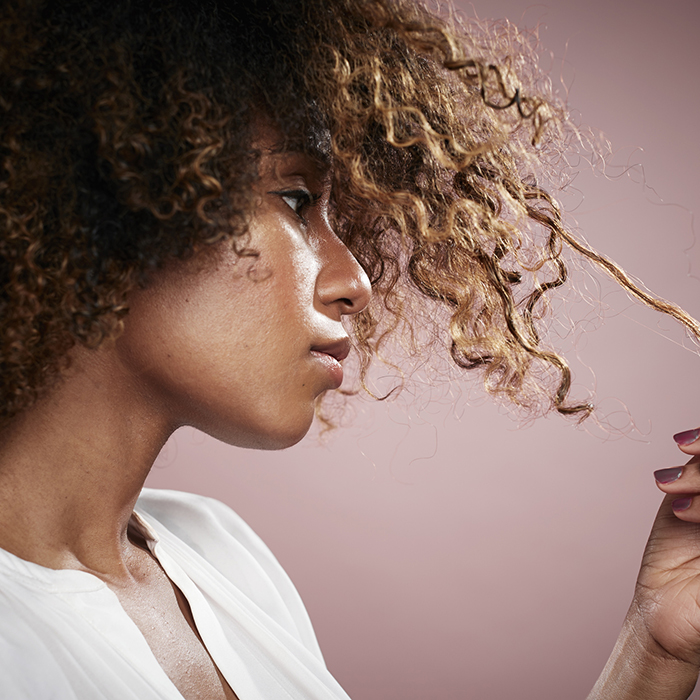
Image Source: Getty Images
Seborrheic dermatitis is a skin condition that causes itchiness, flakes, and scaly patches. It’s not the same as dandruff or psoriasis. It’s actually a chronic form of eczema, and while the exact cause is unknown, scientists think genes and hormones both play a role. It may also be related to a yeast (fungus”> in the oil secretions of the skin.
Sometimes, seborrheic dermatitis goes away without treatment… And sometimes — like in my case — it’s a never-ending chronic condition that’ll probably remain with me until I die. Fun times, I know, but I promise it’s not as bad as it sounds! I used to despair over my frustrating scalp, but now I have a handle on how to deal with it, and honestly? I barely even worry about it anymore.
Here’s how I manage seborrheic dermatitis with my with curly hair and how you can, too!
Step one is acceptance
Dealing with my seborrheic dermatitis was impossible until I finally accepted that 1″> I had it, 2″> it wasn’t my fault, and 3″> it wasn’t going to magically go away. Then, the solutions became about management rather than trying to get rid of it — and I’m happy to say that seborrheic dermatitis IS very manageable. It’s all about finding the combination of natural and medicated products that work for your particular case. With the proper regimen, you can get rid of the flakes entirely and stop thinking about your scalp condition so much.
Natural products for managing seborrheic dermatitis
There is a range of natural products that help decrease the symptoms of seborrheic dermatitis. Here are a few that I’ve personally tried and can recommend:
- Apple cider vinegar: Pure apple cider vinegar, straight onto your scalp. Let it sit for a while and then rinse it out. ACH has natural antibacterial and antifungal qualities. The smell goes away, don’t worry!
- Coconut oil: Coconut oil is another natural antibacterial and antifungal. My doctor recommended that I apply it to my scalp before shampooing; that way, you get the benefits of coconut oil without your scalp becoming overly oily, which can worsen this condition.
- Peppermint oil: Peppermint oil, like any essential oil, needs to be diluted with a carrier oil before you apply it to your skin. It soothes inflammation, and that tingly feeling does wonders for itchiness!
- Tea tree oil: Tea tree oil is another useful antifungal for treating seborrheic dermatitis. Mix a small amount into a carrier oil before applying.
- Evening primrose oil: My doctor suggested that I take evening primrose oil supplements. Evening primrose oil contains GLA, a fatty acid that reduces scalp inflammation.
- Fish oil: Fish oil supplements also contain fatty acids that nourish the scalp.
I’ve never been able to fully treat my seborrheic dermatitis with natural products alone, but they do reduce mild symptoms and provide relief.
If DIY isn’t your thing, I love Cantu Shea Butter Apple Cider Vinegar Root Relief, which contains both ACV and peppermint oil and is so soothing. Other options include EDEN BodyWorks Peppermint Tea Tree Scalp Therapy and Briogeo Scalp Revival Charcoal + Tea Tree Oil Scalp Treatment.
Another natural way to treat seborrheic dermatitis is to do your best to avoid known triggers that exacerbate the condition. These include stress, illness (take your vitamin C!”>, hair products with alcohol, hormonal changes, and harsh shampoos.
The one product I can’t live without: medicated shampoo
Medicated shampoos are far from “natural,” but THEY WORK.
The active ingredient that works best for me is coal tar, which is in Neutrogena T-Gel. I honestly don’t know where I would be without T-Gel — it’s my go-to scalp treatment! As long as I use it at least once a week, my scalp is a non-issue.
Other common active ingredients include pyrithione zinc (like in Head & Shoulders”>, selenium sulfide (like in Selsun Blue”>, ketoconazole, and salicylic acid. You don’t have to get a prescription for any of these shampoos; they’re available over-the-counter.
Medicated shampoos can be extremely drying; like many shampoos, they contain sulfates and will strip your scalp. Unfortunately, there are no sulfate-free medicated shampoos that I know of, although I’d LOVE for someone to invent one! In the meantime, applying coconut oil to my scalp before shampooing really helps. I also tend to co-wash after using the T-Gel to re-moisturize my scalp and roots.

Image Source: @Getty Images
What to do when it becomes unbearable
If natural and over-the-counter products are NOT doing the trick and your scalp is so ridiculously itchy and flaky that you just cannot deal — go to the doctor and ask about getting a prescription treatment.
My doctor prescribed me fluocinolone, which comes in the form of an oil or a cream. I haven’t actually used it in years (thanks to the T-Gel!”>, but when I was initially getting my scalp under control, it truly saved me. Even though I don’t use fluocinolone anymore, it’s reassuring to have it around in case I have a horrible flare-up (hey, ya never know”>.
Fluocinolone is a type of corticosteroid; other types include hydrocortisone, clobetasol, or desonide. There are also antifungal treatments that you can apply as a cream or shampoo. Your doctor will likely prescribe you one of these options at first. They might prescribe you an antifungal medication to take as a pill if other treatments aren’t working.
My doctor advised me to use prescription products as a last resort — use them sparingly as needed, then switch back over to non-prescription products ASAP, to avoid any negative side effects. Your doctor can advise you on how to use yours!
If you have seborrheic dermatitis, what are your GO-TO products for your scalp?!
